Litóhoro, Pieria, Greece, Friday, 8 December 2000
We visited Athens for four days last week. We were trying for five, but we discovered too late that the buses to Athens do not come into Litóhoro at all, though our tickets and the schedule board both said Litóhoro-Athína 09:30. What it turns out you're supposed to do is take one of the regular hourly buses for Kateríni just as far as the coastal highway, and there intercept the bus on its way from Kateríni to Athens. By the time we found this out, the morning of Tuesday 28 November, it was too late; we had missed it. Fortunately we were able to get our tickets changed over for the next bus, five and a half hours later, which we opted to meet and board at the Kateríni station. We noted for future reference just which highway-side shelter it was where both of the buses we took that afternoon stopped, since changing buses there would permit starting the trip a full hour later from Litóhoro, for the same arrival time. As it was, we lost half a day, arriving only in time for a Hellenically late dinner and then to bed at the Marble House; and mindful of the same complication on the return trip, and the possibility of missing the last evening bus from Kateríni to Litóhoro, we decided we had better start back on the 09:45 bus Sunday, rather than the 15:00 as we had originally planned, so there went another half day.
The Marble House was this time even cheaper than when we had stayed there in September, but where before we had been too hot there now we were distinctly chilly, when we were not actually in bed under blankets. Because in the off season there are no staff on the premises after five, it was not until Thursday that we learned that electric space heaters were an option, at guests' expense for the power; and we decided against that for the children, on safety grounds. Perhaps we should have got one for our room, though, since the children were not complaining of the chill--either their room was warmer or they felt it less. Next time I go to Athens (in January, by myself, for library research) I shall try to find a place with heat.
Outdoors, though, we found Athens cool much more pleasant than Athens hot, and we had good and often sunny weather for most of our visit, which was a pleasant surprise after the weather we left in, and the forecasts. We never even opened the four umbrellas we lugged along; it was raining a little in Litóhoro as we made our way (twice!) to the bus station, but with a high wind.
On Wednesday we set out to visit the ancient Agora, the marketplace and general public space of the ancient city, and the setting of many of Plato's dialogues. As I noted before, both the great Attic tragic drama and the democratic assembly originated there in the archaic period, before being transferred to dedicated spaces in the classical period: the Great Theater of Dionysus on the southern slope of the Acropolis, and the hill called the Pnyx, respectively. As it was when Stas and I were first here thirteen and a half years ago, public access to the Pnyx is limited to the summer tourist season, when it serves as seating area for the Acropolis son et lumière show. But one can visit the theater, and we did so on our way to the Agora, by consensus among the children.

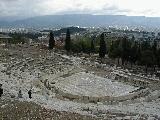 At left you can see the view up from the stage and orchêstra to the seating area or cavea and on up to the Acropolis itself, and one of the caves with which it is riddled at the base (this one is now a chapel dedicated to the Holy Ghost, by reason of a minor spring in there). It would have been to one of those caves that the chorus of furies would have marched in solemn procession through the cavea at the end of the Oresteia of Aeschylus--though I gather it was not this very one. On the right, you see the downward view. The sculptures at the back of the orchêstra are late classical in period, having formerly surmounted the skênê; the rest of the stonework you see is Roman.
At left you can see the view up from the stage and orchêstra to the seating area or cavea and on up to the Acropolis itself, and one of the caves with which it is riddled at the base (this one is now a chapel dedicated to the Holy Ghost, by reason of a minor spring in there). It would have been to one of those caves that the chorus of furies would have marched in solemn procession through the cavea at the end of the Oresteia of Aeschylus--though I gather it was not this very one. On the right, you see the downward view. The sculptures at the back of the orchêstra are late classical in period, having formerly surmounted the skênê; the rest of the stonework you see is Roman.
 Construction blocked the shorter way around the south side of the Acropolis to the Agora, so we found our way around the north, through the Pláka district, a largely pedestrianized and now very touristy region full of tavernas and souvenir shops. On our way, though, we found ourselves in this very picturesque (and exclusively pedestrian) residential neighborhood tucked under the eastern end of the Acropolis. Somebody looks a bit cross here, though.
Construction blocked the shorter way around the south side of the Acropolis to the Agora, so we found our way around the north, through the Pláka district, a largely pedestrianized and now very touristy region full of tavernas and souvenir shops. On our way, though, we found ourselves in this very picturesque (and exclusively pedestrian) residential neighborhood tucked under the eastern end of the Acropolis. Somebody looks a bit cross here, though.
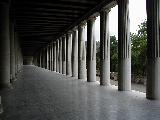 In the Agora, one can promenade here along the front of the Stoa of Attalus. This is a restoration from the 1950s of a building dating only from the second century B.C. (around the time Rome consolidated its hold on Greece); still, it assuredly closely resembles the sort of space in which Socrates might well have walked and talked in the shade, closely examining a definition in company with the person who had proposed it. (More specifically, the image of the teacher walking up and down a stoa while conversing with students comes from Plato's Protagoras; and the teacher who does so is the title character, while the stoa in that case is part of a private house, and so presumably smaller than this, even though it is a rich man's house. The "Stoic" school of philosophy was founded by Zeno more than a century after that scene, and some 140 meters to the northwest of here, in the Stoa Poikilê.)
In the Agora, one can promenade here along the front of the Stoa of Attalus. This is a restoration from the 1950s of a building dating only from the second century B.C. (around the time Rome consolidated its hold on Greece); still, it assuredly closely resembles the sort of space in which Socrates might well have walked and talked in the shade, closely examining a definition in company with the person who had proposed it. (More specifically, the image of the teacher walking up and down a stoa while conversing with students comes from Plato's Protagoras; and the teacher who does so is the title character, while the stoa in that case is part of a private house, and so presumably smaller than this, even though it is a rich man's house. The "Stoic" school of philosophy was founded by Zeno more than a century after that scene, and some 140 meters to the northwest of here, in the Stoa Poikilê.)
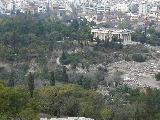 This overview of the Agora, from Areopagus as before, shows the well-preserved fifth-century-B.C. Doric temple of Hephaestus. In the center of the frame, according to our guide Iríni, is the site of Socrates' trial on charges of corrupting Athenian youth and religious innovation, the charges for which he was eventually put to death, at the beginning of the fourth century B.C. Iríni was a local licensed guide we hired for our return visit to the Acropolis on Thursday--rather expensive, or at least seeming so now that we've grown accustomed to this country's cheap cost of living, but quite informative. Some of the information was not new to me; she pointed out the subtle curves in the base of the Parthenon, nicely calculated to appear straighter to the eye than actual straight lines would, and I recall mentioning that fact in a report I wrote in elementary school. Yet again I find that things learned in Mrs. Tweedie's fourth-grade classroom stick with me.
This overview of the Agora, from Areopagus as before, shows the well-preserved fifth-century-B.C. Doric temple of Hephaestus. In the center of the frame, according to our guide Iríni, is the site of Socrates' trial on charges of corrupting Athenian youth and religious innovation, the charges for which he was eventually put to death, at the beginning of the fourth century B.C. Iríni was a local licensed guide we hired for our return visit to the Acropolis on Thursday--rather expensive, or at least seeming so now that we've grown accustomed to this country's cheap cost of living, but quite informative. Some of the information was not new to me; she pointed out the subtle curves in the base of the Parthenon, nicely calculated to appear straighter to the eye than actual straight lines would, and I recall mentioning that fact in a report I wrote in elementary school. Yet again I find that things learned in Mrs. Tweedie's fourth-grade classroom stick with me.
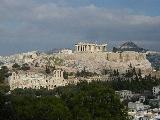
 After our tour of the Acropolis with Iríni, we went to the Hill of Philopappus, so named for a Syrian prince who became an Athenian citizan and served as Roman consul and praetor, and whose monument stands at the summit. (It is also known as Mousíon Hill.) That summit affords a fine prospect of the south side of the Acropolis. A guided group of Japanese tourists were just finishing up there when we arrived, and an olive wreath they had been using as a prop was given to Ariadne. (The hills seen faintly behind her head are those of Salamis, the island in the bay where Themistocles defeated the invading Persians in the great naval battle of 480 B.C.)
After our tour of the Acropolis with Iríni, we went to the Hill of Philopappus, so named for a Syrian prince who became an Athenian citizan and served as Roman consul and praetor, and whose monument stands at the summit. (It is also known as Mousíon Hill.) That summit affords a fine prospect of the south side of the Acropolis. A guided group of Japanese tourists were just finishing up there when we arrived, and an olive wreath they had been using as a prop was given to Ariadne. (The hills seen faintly behind her head are those of Salamis, the island in the bay where Themistocles defeated the invading Persians in the great naval battle of 480 B.C.)
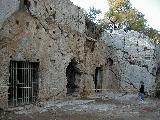 Descending the hill, we found the spot where Socrates reputedly was imprisoned after his trial, and drank the fatal hemlock. Larissa had just read the opening scene of Plato's Crito, which is set here, a few days earlier.
Descending the hill, we found the spot where Socrates reputedly was imprisoned after his trial, and drank the fatal hemlock. Larissa had just read the opening scene of Plato's Crito, which is set here, a few days earlier.
 The next day, Friday, we visited the Keramikós, where one can see remains of the defensive walls of ancient Athens, the sites of two of the gates, and various tombs situated just outside those gates. Among these last was a replica of the exquisite grave stele of the matron Hêgêsô. The photo at left, however, is of the original, now in the National Archaeological Museum, where we spent some hours on Saturday. I applied myself more to being the children's guide than to taking in the exhibits myself--this was not my first visit, after all--and I think it made a difference. The children did say it was their best museum experience yet--but then it is also my favorite collection in the world, and I think its own merits enough to account for anyone's preference.
The next day, Friday, we visited the Keramikós, where one can see remains of the defensive walls of ancient Athens, the sites of two of the gates, and various tombs situated just outside those gates. Among these last was a replica of the exquisite grave stele of the matron Hêgêsô. The photo at left, however, is of the original, now in the National Archaeological Museum, where we spent some hours on Saturday. I applied myself more to being the children's guide than to taking in the exhibits myself--this was not my first visit, after all--and I think it made a difference. The children did say it was their best museum experience yet--but then it is also my favorite collection in the world, and I think its own merits enough to account for anyone's preference.
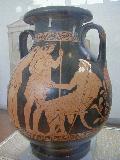 Parts of the museum were closed off for repair of damages inflicted by Poseidon, the earth-shaker, so I was not able to revisit some of my favorite pieces in the collection, like the relief from Eleusis showing Demeter's gift of grain "to men who eat bread." But I was very much taken with this red-figure urn, made to hold human ashes, and figuring on its outside the departure of a beautiful young man from his father's home, for military service in the Peloponnesian war--from which only his ashes returned. I was irresistibly reminded of some choral lines from the Agamemnon of Aeschylus (429-44, here in H. W. Smyth's translation): "In every house of all who went forth together from the land of Hellas, unbearable grief is seen. Many things pierce the heart. Each knows whom he sent forth. But to the home of each come urns and ashes, not living men. Ares barters the bodies of men for gold; he holds his balance in the contest of the spear; and back from Ilium to their loved ones he sends a heavy dust passed through his burning, a dust cried over with plenteous tears, in place of men sending well made urns with ashes."
Parts of the museum were closed off for repair of damages inflicted by Poseidon, the earth-shaker, so I was not able to revisit some of my favorite pieces in the collection, like the relief from Eleusis showing Demeter's gift of grain "to men who eat bread." But I was very much taken with this red-figure urn, made to hold human ashes, and figuring on its outside the departure of a beautiful young man from his father's home, for military service in the Peloponnesian war--from which only his ashes returned. I was irresistibly reminded of some choral lines from the Agamemnon of Aeschylus (429-44, here in H. W. Smyth's translation): "In every house of all who went forth together from the land of Hellas, unbearable grief is seen. Many things pierce the heart. Each knows whom he sent forth. But to the home of each come urns and ashes, not living men. Ares barters the bodies of men for gold; he holds his balance in the contest of the spear; and back from Ilium to their loved ones he sends a heavy dust passed through his burning, a dust cried over with plenteous tears, in place of men sending well made urns with ashes."

 Poseidon, fortunately, had spared the room containing this famous life-size bronze of himself (life-size for humans, anyhow), dating from the height of the classical period and preserved over intervening centuries beneath the sea. The haunted-looking god on the right is Asclepius, a heroic son of Apollo and a great healer like his father, who paid the ultimate price for hubris in raising the dead. His hero cult had evolved into a proper god cult when the original behind this Roman copy was sculpted in the fourth century B.C. The Hippocratic medical tradition developed in the context of this cult.
Poseidon, fortunately, had spared the room containing this famous life-size bronze of himself (life-size for humans, anyhow), dating from the height of the classical period and preserved over intervening centuries beneath the sea. The haunted-looking god on the right is Asclepius, a heroic son of Apollo and a great healer like his father, who paid the ultimate price for hubris in raising the dead. His hero cult had evolved into a proper god cult when the original behind this Roman copy was sculpted in the fourth century B.C. The Hippocratic medical tradition developed in the context of this cult.
Then it was back to Litóhoro on Sunday. On the way back, we told our taxi driver to take us to Kifissoú 100, which turned out to be the wrong bus station, but we had started early enough to get another cab to the correct one, at Liosíon 260, and still arrive in time for our bus. Also this time we were able to make a very tight connection at the coastal highway intersection outside Litóhoro, and thus we arrived home well before dark. Much of the remaining afternoon and evening went into doing homework for our modern Greek lessons Monday morning.
previous entry
next entry
main/ToC page

 At left you can see the view up from the stage and orchêstra to the seating area or cavea and on up to the Acropolis itself, and one of the caves with which it is riddled at the base (this one is now a chapel dedicated to the Holy Ghost, by reason of a minor spring in there). It would have been to one of those caves that the chorus of furies would have marched in solemn procession through the cavea at the end of the Oresteia of Aeschylus--though I gather it was not this very one. On the right, you see the downward view. The sculptures at the back of the orchêstra are late classical in period, having formerly surmounted the skênê; the rest of the stonework you see is Roman.
At left you can see the view up from the stage and orchêstra to the seating area or cavea and on up to the Acropolis itself, and one of the caves with which it is riddled at the base (this one is now a chapel dedicated to the Holy Ghost, by reason of a minor spring in there). It would have been to one of those caves that the chorus of furies would have marched in solemn procession through the cavea at the end of the Oresteia of Aeschylus--though I gather it was not this very one. On the right, you see the downward view. The sculptures at the back of the orchêstra are late classical in period, having formerly surmounted the skênê; the rest of the stonework you see is Roman.









